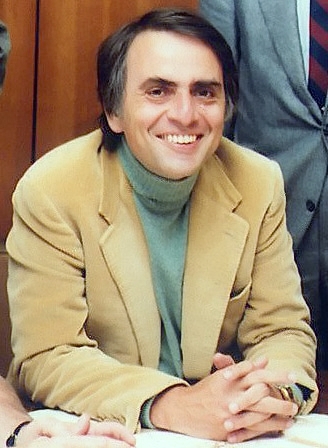Image credit: NASA
I had the biggest crush on Carl Sagan back when the first Cosmos was broadcast -- I still do.
Easier on the eye than most of the TV "teachers" of yore -- and all my real-world science teachers, to be sure -- the man could make anything exciting. And his almost-childlike adoration of the cosmos and its "billions and billions" of stars and planets and galaxies was infectious.
People who didn't even watch the show still imitate him saying "billions and billions." We know exactly who someone is imitating when they say it.
But that catchphrase wasn't all there was to it. That man changed and forever enriched my life in a few well-constructed sentences one evening. He told me the meaning of life. In about 10 seconds. Maybe less.
We are, he said, how the cosmos gets to experience itself. And we, like everything on the planet and beyond, are all made of the same "starstuff."
Think about that for a minute -- it sounds familiar, but really think about it this time.
Though arranged in myriad configurations, we and all things are made of the same stuff. You can trace your ancestry as far back as you want. You can declare your allegiance to whatever country, culture or ethnicity you please. You can debate sexual and social and every other kind of differences and similarities till you're blue in the face.
But you're starstuff, baby. Born of the big bang. Billions and billions of years ago. Do you feel what that means? It rocked my world. It moved me to tears, actually -- I mean, everything really is everything.
Damn, Carl.
The new Cosmos is not Carl's Cosmos, though you hear him speak and referred to a lot -- that's as it should be. But the new Cosmos has a swag of its own -- Neil deGrasse Tyson is a rock star, as critics love to say. He struts through the sets -- real and the computer-generated -- with star style.
But what he shows and tells us would be spellbinding even without that. Cosmos is teaching at its best. Because it never feels like teaching. It feels like the greatest mystery story ever. The greatest action movie ever. The best drama series ever. The best comedy series too, probably. After all, Seth MacFarlane is the executive producer.
And when life is explained this well, it just cannot be beat.
But here's when I knew this Cosmos was going to be almost as memorable and influential as Carl's. You see, there's this... thing called a "water bear." ("Tardigrade" is the real name.) And it has been in the commercials for the show for months.
But I had seen it before that on YouTube, billed as one of the world's weirdest creatures ever. And that little sucker scared me to death.
It reminded me of the monster from Alien -- it has this weird, tube-like thing with little sharp teeth inside it that juts out when it takes a bite. And from the photos and footage I'd seen, I couldn't tell if it was a little microscopic creature or some big sea monster discovered way down there somewhere.
Whatever and wherever it was, I was dreading the day it finally got its "closeup" on the actual show. But in the second episode, Tyson finally introduced the thing. And it turns out that they can survive:
•Temperatures as low as -200°C (-328°F) and as high as 151°C (304°F)
•Being frozen in a block of ice
•A lack of oxygen
•A lack of water for 10 years or more
•Levels of X-ray radiation 1,000 times the lethal human dose
•Most noxious chemicals
•Being boiled in alcohol
•Low air pressure (even the vacuum of space for several days)
•High air pressure (up to 6 times the pressure of the deepest part of the ocean)
C'mon, you gotta give it up for the little guys after all that, right? You really do -- I'm a fan. I even Googled up some more info, including an article that teaches you how to find and feed a pet tardigrade of your very own.
I will not be doing that.
But they're starstuff too. And Cosmos, at its best, makes you curious about and even proud of your kinship with all creatures great and small. And that could accomplish something that very few educators, politicians, environmentalists and scientists have been able to do -- make us really care about all those creatures and the places they live.
And what we're doing to them.
I can sometimes almost feel Carl Sagan looking down from the starstuff to which he has returned as his protégé struts across the screen. He invited a teenaged Tyson to spend a day with him at Cornell back in '75. And now the torch has been passed -- into very capable hands indeed.
Tyson, like his mentor, is teaching viewers to love our world and the billions and billions of other worlds out there waiting to be discovered.
Oh -- and scary little water bears too.
If you're just dying to see a water bear despite my description, here are some wonderful articles, one with a little movie about them too:
http://www.sciencefriday.com/video/01/23/2009/behold-the-mighty-water-bear.html
http://www.dailymail.co.uk/news/article-2280286/Meet-toughest-animal-planet-The-water-bear-survive-frozen-boiled-float-space-live-200-years.html
http://en.wikipedia.org/wiki/Tardigrade
http://www.wikihow.com/Find-and-Care-for-a-Pet-Tardigrade-(-Water-Bear-)

